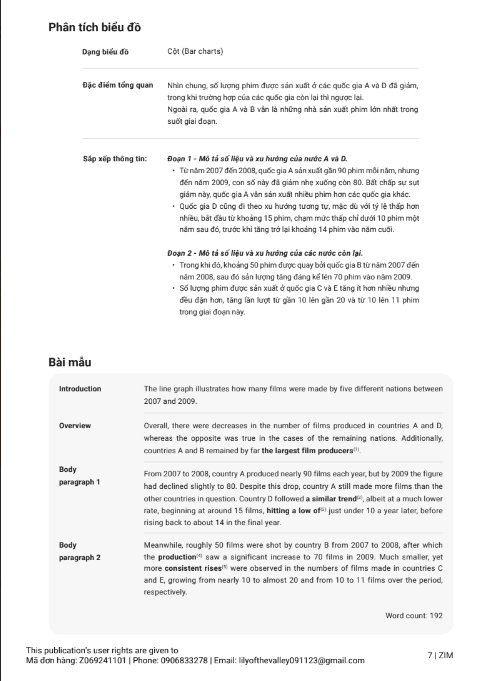


Phân tích biểu đồ
Dạng biểu đồ
Đặc điểm tổng quan
Cột (Bar charts)
Nhìn chung, số lượng phim được sản xuất ở các quốc gia A và D đã giảm, trong khi trường hợp của các quốc gia còn lại thì ngược lại.
Ngoài ra, quốc gia A và B vẫn là những nhà sản xuất phim lớn nhất trong suốt giai đoạn.
Sắp xếp thông tin: Đoạn 1 – Mô tả số liệu và xu hướng của nước A và D.
- Từ năm 2007 đến 2008, quốc gia A sản xuất gần 90 phim mỗi năm, nhưng đến năm 2009, con số này đã giảm nhẹ xuống còn 80. Bất chấp sự sụt giảm này, quốc gia A vẫn sản xuất nhiều phim hơn các quốc gia khác.
- Quốc gia D cũng đi theo xu hướng tương tự, mặc dù với tỷ lệ thấp hơn nhiều, bắt đầu từ khoảng 15 phim, chạm mức thấp chỉ dưới 10 phim một năm sau đó, trước khi tăng trở lại khoảng 14 phim vào năm cuối.
Đoạn 2 – Mô tả số liệu và xu hướng của các nước còn lại.
- Trong khi đó, khoảng 50 phim được quay bởi quốc gia B từ năm 2007 đến năm 2008, sau đó sản lượng tăng đáng kể lên 70 phim vào năm 2009.
- Số lượng phim được sản xuất ở quốc gia C và E tăng ít hơn nhiều nhưng đều đặn hơn, tăng lần lượt từ gần 10 lên gần 20 và từ 10 lên 11 phim trong giai đoạn này.
The line graph illustrates how many films were made by five different nations between 2007 and 2009.
Overall, there were decreases in the number of films produced in countries A and D, whereas the opposite was true in the cases of the remaining nations. Additionally, countries A and B remained by far the largest film producers(1).
From 2007 to 2008, country A produced nearly 90 films each year, but by 2009 the figure had declined slightly to 80. Despite this drop, country A still made more films than the other countries in question. Country D followed a similar trend(2), albeit at a much lower rate, beginning at around 15 films, hitting a low of(3) just under 10 a year later, before rising back to about 14 in the final year.
Bài mẫu
Introduction
Overview
Body paragraph 1
Body paragraph 2
Meanwhile, roughly 50 films were shot by country B from 2007 to 2008, after which the production(4) saw a significant increase to 70 films in 2009. Much smaller, yet more consistent rises(5) were observed in the numbers of films made in countries C and E, growing from nearly 10 to almost 20 and from 10 to 11 films over the period, respectively.
Word count: 192
Câu được chọn:
“The line graph illustrates how many films were made by five different nations between 2007 and 2009.”
Cấu trúc câu
- Chủ ngữ (S): The line graph
- Cụm danh từ
- Vai trò: Chủ ngữ
- Động từ (V): illustrates
- Động từ chính
- Tân ngữ (O): how many films were made by five different nations between 2007 and 2009
- Mệnh đề danh từ
- Vai trò: Tân ngữ của “illustrates”
Phân tích chi tiết của các cụm từ trong tân ngữ
4. how many films were made by five different nations between 2007 and 2009
- Chủ ngữ (S): how many films
- Động từ (V): were made
- Cụm giới từ: by five different nations → chỉ tác nhân
- Cụm giới từ: between 2007 and 2009 → chỉ thời gian
Introduction
Sau đây là một số cấu trúc ngữ pháp nổi bật được sử dụng trong bài mẫu ở trên, và chúng có thể được áp dụng một cách linh hoạt cho các đề khác có đặc điểm tương tự:
Câu được chọn:
“Countries A and B remained by far the largest film producers.”
Cấu trúc câu
- Chủ ngữ: Countries A and B
- Động từ: remained
- Bổ ngữ: by far the largest film producers
- “by far”: cụm trạng từ nhấn mạnh
- “the largest film producers”: cụm danh từ so sánh
Overview
Body paragraph 1
Câu được chọn:
“From 2007 to 2008, country A produced nearly 90 films each year, but by 2009 the figure had declined slightly to 80.”
(giữ nguyên toàn bộ phân tích như bạn cung cấp)
Body paragraph 2
Câu được chọn:
“Roughly 50 films were shot by country B from 2007 to 2008, after which the production saw a significant increase to 70 films in 2009.”
(giữ nguyên toàn bộ phân tích như bạn cung cấp)
Phân tích từ vựng
1. The largest film producers
Loại từ: The (mạo từ), largest (tính từ), film (danh từ), producers (danh từ)
Nghĩa: Các nhà sản xuất phim lớn nhất
2. A similar trend
Nghĩa: Một xu hướng tương tự
3. Hit a low of
Nghĩa: Đạt mức thấp nhất là
4. Production
Nghĩa: Sự sản xuất
5. Consistent rises
Nghĩa: Sự gia tăng đều đặn
Task 2
People believe that they should be able to keep all the money they earn and should not pay tax to the state.
To what extent do you agree or disagree with this statement?
Phân tích đề bài
Dạng bài: Opinion
Từ khoá: keep all the money they earn, not pay tax to the state.
Người viết cần đưa ra quan điểm và lý giải có ví dụ. Có 3 hướng tiếp cận:
- Đồng ý hoàn toàn
- Không đồng ý hoàn toàn
- Đồng ý một phần
Brainstorming section
Bảng ý tưởng
| AGREE | DISAGREE | PARTLY AGREE |
|---|---|---|
| Individual Freedom and Rights | Public Goods and Services | Necessary but Fair |
| Increased Motivation and Productivity | Social Equity | Tax Reforms |
| Economic Growth | Economic Stability | Efficient Resource Allocation |
| Efficient Resource Allocation | National Defense | — |
| Reduced Government Waste | Collective Responsibility | — |
(giữ nguyên toàn bộ nội dung từng mục như bạn cung cấp)
Cấu trúc chi tiết của bài viết
- Mở bài
- Paraphrased Topic
- Thesis statement
- Thân bài 1
- Topic Sentence
- Explanation
- Evidence / Example
- Link
- Thân bài 2
- Topic Sentence
- Explanation
- Evidence / Example
- Link
- Kết bài
- Restated thesis
- Summarized main points
Bài mẫu 1: Hoàn toàn không đồng ý
Some people argue that they should be entitled to retain(1) all the money they earn without paying taxes to the state. However, I totally disagree with this view.
Firstly, taxes are essential for funding public goods and services(2) that benefit everyone in society. Without taxes, the government would be unable to provide critical services(3) such as healthcare, education, infrastructure, and public safety. For example, public hospitals and schools rely heavily on tax revenue(4) to operate and maintain their services. If individuals kept all their earnings, these vital services would suffer, leading to a decline in the overall quality of life(5). Therefore, taxes are a necessary contribution to the common good(6), ensuring that essential services are available to all citizens.
Secondly, taxes play a crucial role in reducing income inequality(7) and promoting social equity(8). Through a progressive tax system(9), where higher earners pay a larger percentage of their income, the government can redistribute wealth(10) and provide support to the less fortunate(11). This helps to create a more balanced and fair society. For instance, social welfare programs and unemployment benefits, funded by taxes, offer a safety net(12) for those in need. By contributing to these programs, individuals help to create a more just and equitable society. Thus, paying taxes is a way to ensure that everyone has access to basic necessities and opportunities for a better life.
In conclusion, I firmly disagree with the notion that people should keep all the money they earn and not pay taxes since taxes are indispensable(13) for funding public services and reducing income inequality. Hence, ensuring a well-functioning society(14) requires that everyone contributes their fair share through taxation.
Word count: 272
Introduction
1. Retain
- Loại từ: Động từ
- Nghĩa tiếng Anh: Continue to have (something); keep possession of.
- Dịch nghĩa: Giữ lại, duy trì
- Ví dụ: “The company needs to retain its talented employees.”
(Công ty cần giữ lại những nhân viên tài năng của mình.)
Body Paragraph 1
2. Public goods and services
- Loại từ:
- Public: Tính từ
- Goods: Danh từ (số nhiều)
- And: Liên từ
- Services: Danh từ (số nhiều)
- Nghĩa tiếng Anh: Products and services that are provided by the government for the benefit of all citizens.
- Dịch nghĩa: Hàng hóa và dịch vụ công cộng
- Ví dụ: “Public goods and services like roads and education are essential for society.”
(Hàng hóa và dịch vụ công cộng như đường xá và giáo dục là cần thiết cho xã hội.)
3. Critical services
- Loại từ:
- Critical: Tính từ
- Services: Danh từ (số nhiều)
- Nghĩa tiếng Anh: Essential services that are crucial for the functioning of society, such as healthcare and emergency services.
- Dịch nghĩa: Dịch vụ quan trọng
- Ví dụ: “Access to critical services like healthcare is vital for public health.”
(Tiếp cận các dịch vụ quan trọng như chăm sóc sức khỏe là rất quan trọng cho sức khỏe cộng đồng.)
4. Tax revenue
- Loại từ:
- Tax: Danh từ
- Revenue: Danh từ
- Nghĩa tiếng Anh: The income that is gained by governments through taxation.
- Dịch nghĩa: Doanh thu từ thuế
- Ví dụ: “Tax revenue is used to fund public services and infrastructure.”
(Doanh thu từ thuế được sử dụng để tài trợ cho các dịch vụ công cộng và cơ sở hạ tầng.)
5. The common good
- Loại từ:
- The: Mạo từ
- Common: Tính từ
- Good: Danh từ
- Nghĩa tiếng Anh: The benefit or interests of all.
- Dịch nghĩa: Lợi ích chung
- Ví dụ: “Policies should be designed to promote the common good.”
(Các chính sách nên được thiết kế để thúc đẩy lợi ích chung.)
Body Paragraph 2
6. Income inequality
- Loại từ:
- Income: Danh từ
- Inequality: Danh từ
- Nghĩa tiếng Anh: The unequal distribution of household or individual income across participants in an economy.
- Dịch nghĩa: Sự bất bình đẳng thu nhập
- Ví dụ: “Income inequality can lead to social and economic issues.”
(Sự bất bình đẳng thu nhập có thể dẫn đến các vấn đề xã hội và kinh tế.)
7. Social equity
- Loại từ:
- Social: Tính từ
- Equity: Danh từ
- Nghĩa tiếng Anh: Fairness and justice in social policy, ensuring equal opportunities and rights for all.
- Dịch nghĩa: Công bằng xã hội
- Ví dụ: “Social equity is essential for a harmonious society.”
(Công bằng xã hội là cần thiết cho một xã hội hài hòa.)
8. A progressive tax system
- Loại từ:
- A: Mạo từ
- Progressive: Tính từ
- Tax: Danh từ
- System: Danh từ
- Nghĩa tiếng Anh: A tax system in which the tax rate increases as the taxable amount increases.
- Dịch nghĩa: Hệ thống thuế lũy tiến
- Ví dụ: “A progressive tax system helps to reduce income inequality.”
(Hệ thống thuế lũy tiến giúp giảm bớt sự bất bình đẳng thu nhập.)
9. Redistribute wealth
- Loại từ:
- Redistribute: Động từ
- Wealth: Danh từ
- Nghĩa tiếng Anh: The process of distributing wealth from the rich to the poor to reduce economic inequalities.
- Dịch nghĩa: Phân phối lại của cải
- Ví dụ: “Governments often use taxes to redistribute wealth.”
(Chính phủ thường sử dụng thuế để phân phối lại của cải.)
(Số 10 là trùng lặp, giữ nguyên theo tài liệu gốc)
10. Redistribute wealth
- Loại từ: Như trên
- Nghĩa tiếng Anh: Như trên
- Dịch nghĩa: Như trên
- Ví dụ: Như trên
Conclusion
13. Indispensable
- Loại từ: Tính từ
- Nghĩa tiếng Anh: Absolutely necessary; essential.
- Dịch nghĩa: Không thể thiếu; cần thiết
- Ví dụ: “Clean water is indispensable for human survival.”
(Nước sạch là không thể thiếu cho sự sống của con người.)
14. A well-functioning society
- Loại từ:
- A: Mạo từ
- Well-functioning: Tính từ
- Society: Danh từ
- Nghĩa tiếng Anh: A society that operates efficiently and effectively, ensuring the well-being of its members.
- Dịch nghĩa: Một xã hội hoạt động tốt
- Ví dụ: “Education and healthcare are crucial for a well-functioning society.”
(Giáo dục và chăm sóc sức khỏe là rất quan trọng cho một xã hội hoạt động tốt.)



